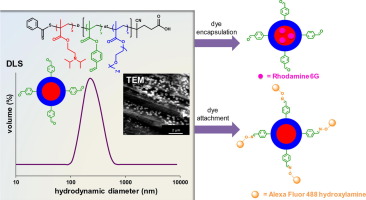当前位置:
X-MOL 学术
›
Eur. Polym. J.
›
论文详情
Our official English website, www.x-mol.net, welcomes your
feedback! (Note: you will need to create a separate account there.)
pH-Responsive benzaldehyde-functionalized PEG-based polymeric nanoparticles for drug delivery: Effect of preparation method on morphology, dye encapsulation and attachment
European Polymer Journal ( IF 5.8 ) Pub Date : 2020-02-01 , DOI: 10.1016/j.eurpolymj.2019.109471 Peter Smyth , Thomas J. Gibson , Gavin Irvine , Gemma Black , Daniel Lavery , Mona Semsarilar , Christopher J. Scott , Efrosyni Themistou
European Polymer Journal ( IF 5.8 ) Pub Date : 2020-02-01 , DOI: 10.1016/j.eurpolymj.2019.109471 Peter Smyth , Thomas J. Gibson , Gavin Irvine , Gemma Black , Daniel Lavery , Mona Semsarilar , Christopher J. Scott , Efrosyni Themistou

|
Abstract Functionalized, pH-responsive and biocompatible polymeric nanoparticles have attracted the interest of many researchers working on novel pharmaceutical formulations. Here, in an effort to develop an efficient drug delivery formulation, all these properties are combined in one polymeric nanoparticle system. More specifically, benzaldehyde-functionalized amphiphilic block copolymers based on PEG-based oligo(ethylene glycol) methacrylate (OEGMA), benzaldehyde-containing para-formyl phenyl methacrylate (pFPMA) and pH-responsive 2-(diisopropyl)aminoethyl methacrylate (DPA) monomers are readily prepared by reversible addition-fragmentation chain transfer (RAFT) polymerization. pH-Switch and single emulsion-solvent evaporation post-polymerization processing methods are used to prepare benzaldehyde-functionalized PEGylated pH-responsive nanoparticles with diameters of 180–230 nm. After nanoparticle formation, the benzaldehyde groups on the surface are shown to react with an Alexa Fluor 488 hydroxylamine dye through oxime bond formation, illustrating the potential for these particles to be surface-functionalized with biologically important molecules, such as fluorescent dyes for tracking their intracellular fate or antibodies for targeted therapy. Encapsulation of Nile Red and rhodamine 6G dyes is performed during the post-polymerization processing step for nanoparticle formation. Nanoparticles with a fluorescent cargo were shown to be successfully internalized in both A2780 ovarian cancer and A549 lung epithelial human cells in vitro, further illustrating the potential for these formulations to be used as triggered release therapeutic drug delivery vehicles.
中文翻译:

用于药物递送的 pH 响应性苯甲醛官能化基于 PEG 的聚合物纳米粒子:制备方法对形态、染料包封和附着的影响
摘要 功能化、pH 响应性和生物相容性的聚合物纳米粒子引起了许多研究新型药物制剂的研究人员的兴趣。在这里,为了开发一种有效的药物递送配方,所有这些特性都结合在一个聚合物纳米颗粒系统中。更具体地说,苯甲醛官能化的两亲性嵌段共聚物基于基于 PEG 的低聚(乙二醇)甲基丙烯酸酯 (OEGMA)、含苯甲醛的甲基丙烯酸对甲酰基苯酯 (pFPMA) 和 pH 响应性 2-(二异丙基) 氨基乙基甲基丙烯酸酯 (DPA) 单体很容易通过可逆加成断裂链转移 (RAFT) 聚合制备。pH-Switch 和单乳液溶剂蒸发后聚合处理方法用于制备直径为 180-230 nm 的苯甲醛功能化聚乙二醇化 pH 响应纳米粒子。纳米颗粒形成后,表面的苯甲醛基团显示通过肟键形成与 Alexa Fluor 488 羟胺染料反应,说明这些颗粒有可能被生物学上重要的分子(例如用于追踪其细胞内的荧光染料)进行表面功能化。靶向治疗的命运或抗体。尼罗红和罗丹明 6G 染料的封装是在形成纳米颗粒的聚合后加工步骤中进行的。
更新日期:2020-02-01
中文翻译:

用于药物递送的 pH 响应性苯甲醛官能化基于 PEG 的聚合物纳米粒子:制备方法对形态、染料包封和附着的影响
摘要 功能化、pH 响应性和生物相容性的聚合物纳米粒子引起了许多研究新型药物制剂的研究人员的兴趣。在这里,为了开发一种有效的药物递送配方,所有这些特性都结合在一个聚合物纳米颗粒系统中。更具体地说,苯甲醛官能化的两亲性嵌段共聚物基于基于 PEG 的低聚(乙二醇)甲基丙烯酸酯 (OEGMA)、含苯甲醛的甲基丙烯酸对甲酰基苯酯 (pFPMA) 和 pH 响应性 2-(二异丙基) 氨基乙基甲基丙烯酸酯 (DPA) 单体很容易通过可逆加成断裂链转移 (RAFT) 聚合制备。pH-Switch 和单乳液溶剂蒸发后聚合处理方法用于制备直径为 180-230 nm 的苯甲醛功能化聚乙二醇化 pH 响应纳米粒子。纳米颗粒形成后,表面的苯甲醛基团显示通过肟键形成与 Alexa Fluor 488 羟胺染料反应,说明这些颗粒有可能被生物学上重要的分子(例如用于追踪其细胞内的荧光染料)进行表面功能化。靶向治疗的命运或抗体。尼罗红和罗丹明 6G 染料的封装是在形成纳米颗粒的聚合后加工步骤中进行的。











































 京公网安备 11010802027423号
京公网安备 11010802027423号